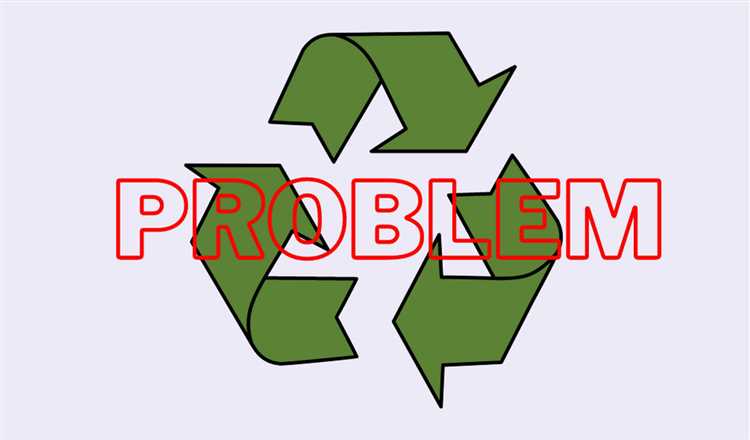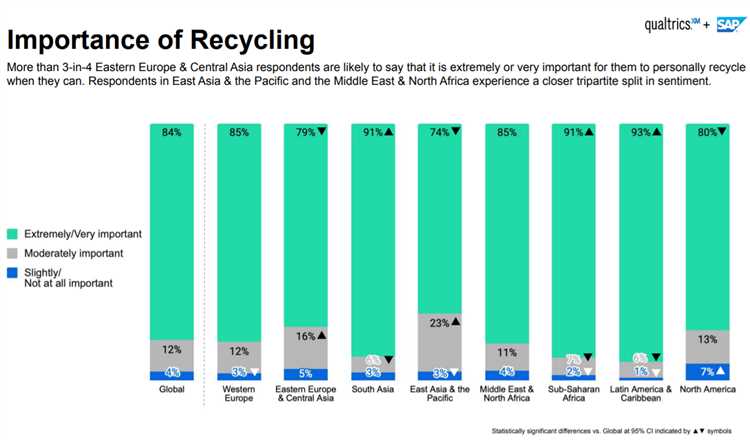
Recycling has become an increasingly important topic in today’s society, as we strive to find ways to reduce waste and protect the environment. While many countries have made significant progress in implementing recycling programs, the United States has been lagging behind. Despite the clear benefits of recycling, Americans continue to struggle with embracing this sustainable practice.
So, what are the reasons behind America’s slow progress in recycling? There are several challenges that contribute to this issue. One major hurdle is the lack of a cohesive national recycling policy and infrastructure. Unlike many other countries that have established comprehensive recycling systems, the United States has yet to develop a unified approach.
In addition to the lack of a national framework, there is also a lack of awareness and education regarding recycling in America. Many Americans are unaware of the importance of recycling or the impact their actions have on the environment. This lack of understanding often leads to apathy and indifference towards recycling.
- The Current State of Recycling in America
- Inadequate Recycling Infrastructure
- Inconsistent Recycling Systems
- Insufficient Education and Public Awareness
- Misconceptions and Lack of Awareness
- Fragmented Recycling Policies
- Limited Access to Recycling Programs
- Low Market Demand for Recycled Materials
- Barriers to Funding
- Inadequate Government Funding
- Limited Private Investment
- Question-answer:
- What are the main reasons why America lags behind in recycling?
- How do national recycling policies and regulations affect recycling rates in America?
- What is the impact of a lack of infrastructure and investment in recycling facilities?
- Why is public awareness and education about recycling important?
- How can industries and businesses contribute to improving recycling rates in America?
The Current State of Recycling in America
Recycling plays an important role in sustainable waste management, but the current state of recycling in America is far from ideal. Despite efforts to promote recycling and increase public awareness, the nation still lags behind other developed countries.
One of the main challenges that America faces in recycling is the lack of a standardized recycling system. Every state, and sometimes even every city, has its own set of recycling rules and guidelines. This lack of uniformity makes it confusing for the public to understand what can and cannot be recycled, resulting in high contamination rates in recycling bins.
Another issue is the lack of infrastructure for recycling. While most communities have recycling programs, they often lack the necessary facilities to properly process and sort recyclable materials. This leads to a significant amount of recyclables ending up in landfills instead of being repurposed.
Furthermore, there is a lack of education around recycling. Many Americans are unaware of the environmental benefits of recycling and the importance of reducing waste. This, coupled with the confusion caused by inconsistent recycling guidelines, contributes to low recycling rates across the country.
In addition, the economic viability of recycling is a challenge. The cost of collecting, processing, and recycling materials often exceeds the revenue generated from selling the recycled products. As a result, recycling programs struggle to stay financially sustainable.
Overall, the current state of recycling in America is characterized by a lack of standardization, inadequate infrastructure, insufficient education, and economic challenges. Addressing these issues will be key to improving recycling rates and moving towards a more sustainable future.
Inadequate Recycling Infrastructure

One of the main reasons why America lags behind in recycling is its inadequate recycling infrastructure. While there has been a growing awareness and interest in recycling among the public, the lack of proper infrastructure hinders the country’s recycling efforts.
In many parts of the United States, recycling facilities and collection systems are limited or non-existent. This means that even if people want to recycle, they may not have access to the necessary resources and facilities to do so. This lack of infrastructure leads to increased landfill waste and lost opportunities for recycling.
Additionally, the existing recycling infrastructure in the country is often outdated and inefficient. Many recycling facilities lack the necessary equipment and technology to effectively sort and process different types of recyclable materials. As a result, a significant amount of recyclables end up being contaminated or improperly handled, reducing the overall recycling rates.
Inconsistent Recycling Systems
Another challenge is the lack of consistent recycling systems across different states and localities. Recycling regulations and practices vary widely across the country, making it confusing for both residents and businesses to know what can and cannot be recycled. This inconsistency leads to increased contamination of recycling streams and lowers the overall quality of recycled materials.
Furthermore, the lack of standardized recycling systems makes it difficult for recycling companies to operate efficiently on a national scale. Inconsistent recycling practices also hinder the development of a robust domestic recycling industry, as it becomes more challenging to create a consistent supply of high-quality recycled materials for manufacturing.
Insufficient Education and Public Awareness

Despite growing concern about environmental issues, there is still insufficient education and public awareness regarding recycling in many parts of the United States. Many people are still unaware of the importance of recycling or are unsure about how to properly recycle their waste.
Without proper education, individuals may not understand the difference between recyclable and non-recyclable materials or the proper way to separate and prepare their recyclables. This lack of knowledge adds to the contamination of recycling streams and decreases the efficiency of recycling efforts.
Increasing public awareness and providing comprehensive education programs about recycling can help improve recycling rates and reduce contamination. By educating individuals about the benefits of recycling and providing clear guidelines on how to recycle correctly, it is possible to overcome the inadequate recycling infrastructure and make significant progress in recycling in the United States.
Misconceptions and Lack of Awareness
One of the major challenges that the United States faces in its recycling efforts is a series of misconceptions and a general lack of awareness among the public. Many individuals still hold the belief that recycling is a waste of time and resources, mistakenly thinking that it is not worth the effort. This misconception often stems from a lack of understanding about the positive impact that recycling can have on the environment and the economy.
Another common misconception is that all recyclable materials are treated the same way and that there is no need to separate different types of waste. This misconception leads to contamination of recyclables, resulting in a lower quality of recycled materials. In reality, proper sorting and separation of different materials is crucial in ensuring that they can be effectively recycled.
Furthermore, a significant amount of Americans are simply not aware of the recycling options and facilities available to them. This lack of knowledge contributes to a lack of motivation and engagement in recycling practices. Many people do not know where or how to recycle, and as a result, they end up throwing away recyclable materials.
In order to overcome these challenges, it is essential to educate the public about the importance of recycling and the proper methods of recycling different materials. Increased awareness campaigns can help dispel misconceptions and provide individuals with clear instructions on how to participate in recycling programs. By fostering a greater understanding and awareness of recycling, the United States can work towards closing the gap and improving its recycling rates.
Fragmented Recycling Policies
One of the main challenges that the United States faces in regards to recycling is the fragmented recycling policies that exist across different states and even within cities. Unlike other countries with centralized recycling programs, the United States lacks a cohesive national recycling policy, resulting in a patchwork of regulations and practices.
Each state has its own set of recycling requirements, which vary in terms of materials accepted, collection methods, and funding mechanisms. This lack of consistency makes it difficult for businesses and individuals to navigate the recycling system and understand what can and cannot be recycled.
Furthermore, recycling policies can differ even within a single city, leading to confusion and inconsistent recycling practices among residents. For example, in some cities, certain types of plastics may be accepted for recycling, while in others they may not be. This inconsistency undermines the effectiveness of recycling efforts and discourages widespread participation.
The fragmented recycling policies also create challenges for recycling infrastructure. As each state and city has its own recycling regulations, there is no standardized infrastructure in place to handle recycling materials. This lack of consistency hampers the development of efficient recycling systems and limits the ability to invest in advanced technologies.
To address the issue of fragmented recycling policies, there is a need for greater coordination and cooperation at the national level. A cohesive national recycling policy would provide clarity and consistency, making it easier for businesses, individuals, and recycling facilities to operate effectively. Additionally, increased investment in recycling infrastructure and technology would help improve the efficiency and effectiveness of recycling efforts across the country.
Overall, the fragmentation of recycling policies in the United States presents a significant challenge to achieving higher recycling rates and reducing waste. By working towards a more unified and standardized approach to recycling, the country can make strides towards a more sustainable future.
Limited Access to Recycling Programs
One major challenge that contributes to America’s lagging recycling rates is limited access to recycling programs. While the availability of recycling programs varies across different states and cities, many areas still do not provide adequate access to recycling facilities for residents and businesses.
This lack of access is particularly pronounced in rural areas and low-income communities. In these regions, the distance to the nearest recycling facility can be significant, making it impractical and costly for individuals to transport their recyclables. As a result, many people simply throw recyclable materials in the trash instead of making the effort to recycle.
Furthermore, even in areas where recycling programs exist, the collection and disposal of recyclables may be limited or inconsistent. Some communities offer curbside pickup for recyclables, while others require residents to drop off their materials at designated recycling centers. These varying collection methods can be confusing for individuals and businesses, discouraging them from participating in recycling efforts.
In addition to limited physical access, educational barriers also contribute to the lack of recycling participation. Many Americans are not aware of the recycling programs available to them or how to properly recycle different materials. This lack of awareness leads to a significant amount of recyclable materials being disposed of as waste.
To increase access to recycling programs, it is crucial for local governments and organizations to invest in the expansion of recycling infrastructure. This includes establishing more recycling centers and expanding curbside pickup services. Additionally, efforts should be made to educate the public about the benefits of recycling and provide clear guidelines on proper recycling practices.
By addressing the issue of limited access to recycling programs, America can take a significant step towards improving its recycling rates and reducing waste.
Low Market Demand for Recycled Materials
One of the major challenges that America faces in recycling is the low market demand for recycled materials. Although recycling has become more popular in recent years, there is still a significant gap between the amount of materials that are recycled and the amount that can be effectively sold or used in new products.
One reason for this low market demand is the lack of consumer awareness and understanding of the value of recycled materials. Many people still do not realize that products made from recycled materials can be just as durable and high-quality as those made from virgin materials.
Another factor is the perception that recycled materials are more expensive than virgin materials. While it is true that the initial cost of producing goods from recycled materials may be slightly higher due to the extra processing required, the long-term benefits, such as reduced energy consumption and lower waste disposal costs, can outweigh these initial costs.
In addition, there are limited options for consumers to purchase products made from recycled materials. Many retailers do not stock a wide variety of products made from recycled materials, making it difficult for consumers to make sustainable choices.
Furthermore, there is also a lack of government policies and incentives to promote the use of recycled materials. Without proper regulations and incentives in place, businesses may not see the economic benefits of utilizing recycled materials in their production processes.
To overcome these challenges, it is crucial to increase consumer education and awareness about the benefits of recycling and the value of recycled materials. Governments can also play a role in implementing policies and incentives to encourage businesses to use more recycled materials.
By addressing the low market demand for recycled materials, America can make significant progress towards a more sustainable and environmentally-friendly future.
Barriers to Funding
One of the main challenges that has hindered the progress of recycling in America is the lack of funding. While recycling is an essential practice for environmental sustainability, it often requires significant financial resources to establish and maintain recycling programs effectively.
Inadequate Government Funding

One major barrier to funding recycling efforts is the inadequate support from the government. Many recycling programs heavily rely on grants and funding from state and local authorities to cover the costs of collection, transportation, and processing of recyclable materials. However, these funding sources are often limited and inconsistent.
Furthermore, government budgets are typically tight, and recycling is often seen as an optional expense rather than a critical investment. Many policymakers prioritize other essential services over recycling, resulting in inadequate funding for infrastructure development, public outreach campaigns, and education about recycling practices.
Limited Private Investment
Another significant barrier to funding recycling endeavors is the limited private investment in the industry. While there are various waste management companies, recycling projects often require substantial capital investment to establish or expand recycling facilities and technologies.
Recycling ventures may struggle to attract private investors due to the perceived risks and uncertainties associated with the industry. There are concerns about the profitability of recycling ventures, particularly when the market prices of recycled materials fluctuate. This lack of private investment hampers the growth and expansion of recycling programs and limits their overall effectiveness.
| Barriers to Funding | Description |
|---|---|
| Inadequate Government Funding | Limited financial support from the government |
| Limited Private Investment | Insufficient capital investment from private companies |
To overcome these barriers, it is crucial for both the government and private sector to recognize the value of recycling and allocate sufficient funding to support recycling initiatives. Increased government funding, stable grants, and incentives for private investment can help foster the development of robust recycling infrastructure and programs that are essential for a sustainable future.
Question-answer:
What are the main reasons why America lags behind in recycling?
America lags behind in recycling due to several main reasons. First, there is a lack of national recycling policies and regulations. Second, there is a lack of infrastructure and investment in recycling facilities. Third, there is a lack of public awareness and education about recycling. Finally, there is a lack of support from industries and businesses to prioritize recycling.
How do national recycling policies and regulations affect recycling rates in America?
National recycling policies and regulations play a crucial role in recycling rates in America. In countries with strong regulations and policies, such as Germany or Sweden, recycling rates are much higher compared to the United States. These policies create a framework for recycling, setting targets, and providing financial incentives for recycling. Without such policies, it is challenging to drive recycling efforts effectively at a national level.
What is the impact of a lack of infrastructure and investment in recycling facilities?
The lack of infrastructure and investment in recycling facilities severely hinders recycling rates in America. Without proper recycling facilities, collected recyclables often end up in landfills or are exported to other countries. This not only leads to a waste of valuable resources but also contributes to pollution and environmental degradation. To improve recycling rates, it is crucial to invest in building and upgrading recycling facilities across the country.
Why is public awareness and education about recycling important?
Public awareness and education about recycling are essential for improving recycling rates. Many people in America are still unaware of the benefits of recycling and the correct ways to recycle. Public awareness campaigns and educational programs can help change attitudes and behaviors towards recycling. By educating the public about the importance of recycling and providing clear guidelines on how to separate and dispose of recyclables properly, we can increase recycling participation and reduce contamination.
How can industries and businesses contribute to improving recycling rates in America?
Industries and businesses have a significant role to play in improving recycling rates in America. They can take several steps to support recycling, such as implementing sustainable packaging designs, promoting the use of recycled materials in their products, and investing in advanced recycling technologies. Additionally, businesses can collaborate with local recycling facilities and participate in recycling programs to ensure proper disposal and recycling of their waste materials. By prioritizing recycling and circular economy principles, industries and businesses can contribute to a more sustainable future.